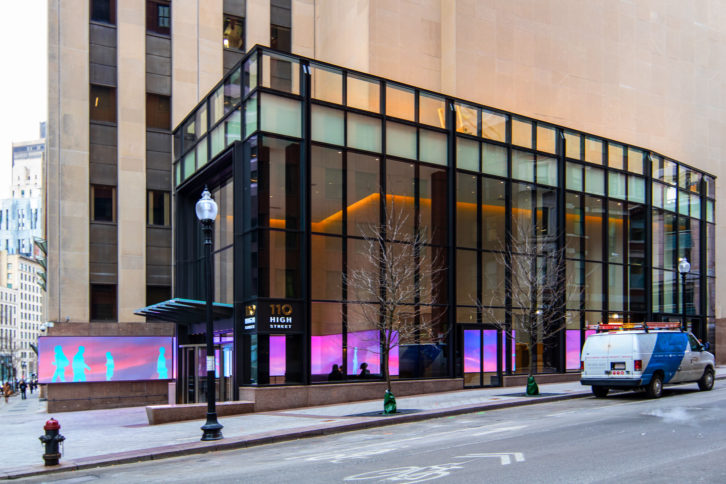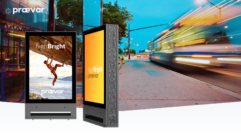
Located in Boston’s Financial District, 110 High Street is a landmark building with Art Deco style architecture and a striking glass lobby. The owner, LaSalle Investment Management, engaged ESI Design to create a new identity and media experience for the building as part of brand repositioning and updates to the property. They wanted to create more presence in the neighborhood and attract tech tenants. ESI Design developed a new building logo and then created a large-scale digital media band, integrated into the architecture of the building, designed by Elkus Manfredi Architects.
The 7 ft high by 84 ft wide 3.9mm LED interactive installation begins around the exterior corner of the building, moves inside, and wraps around the lobby to blur the lines between indoors and outdoors, visible even at night. The content centers on the flow of Boston: an epic-scale media band featuring animated silhouettes and schools of fish that react to people as they pass by the building and through the lobby. Both interior and exterior portions of the 590 square foot media band are reactive.
The installation has three modes, powered by game engines. The first is “Silhouette Mode”, with figures of people that stroll across the screens. The figures change in quantity and pace, reflecting the flow of building users during commute times. As people enter and leave the building, the playful figures on the screen react, wave, and dance. Their garments change depending on the weather. An occasional giraffe or moose makes an appearance in the crowd suggesting a dreamlike quality. The figures and content changes for holidays and events, to support the beloved Red Sox, Patriots, and Bruins games and iconic local events such as the Marathon and St. Patrick’s Day.
In “Bay Mode,” an underwater vista fills the screens with native Charles River fish as schools of scup, bass, and cod gather around visitors in front of the band. Whales and seals occasionally appear and if people linger, a jellyfish might come into view. There are three different aquatic environments, supported by dynamic lighting that changes throughout the day.
In the practical “Building ID/Tenant Message Mode,” property management can customize messaging to showcase the building’s brand and features customized tenant messaging. A simulated cloth background adds visual interest while remaining neutral to avoid distracting from the building messaging.
Sensors installed in the ceiling provide two zones of interaction. The first zone is reactive and picks up on general foot traffic through the space, then changing the pace of the graphics at the screens accordingly. Another zone enables users to interact more directly and intimately with the media display.
Animations are driven by LIDAR sensors (Light Detection and Ranging Sensor) to generate real-time changes to content. Administrators can change digital content through a CMS back-end. Graphics are generated in Unreal Engine, a real-time rendering platform typically used for gaming.
Fabrication was by Dimensional Communications, systems integration by Electrosonic, CMS and sensor software by AV&C, software development by Arbitrarily Good Productions.










